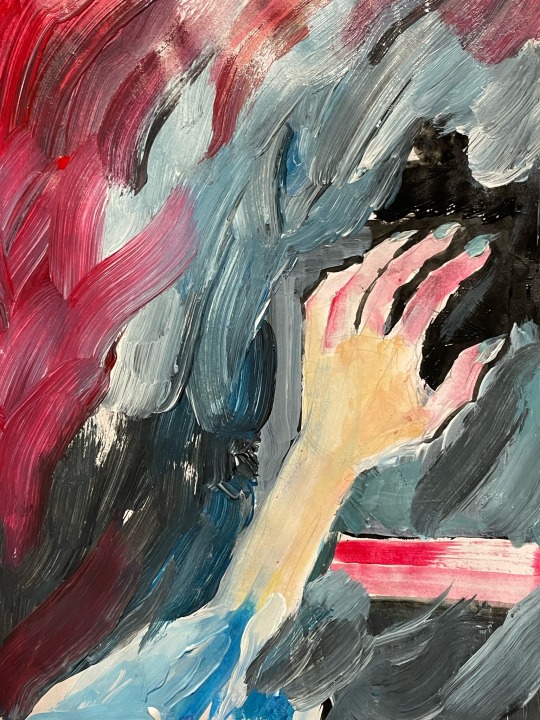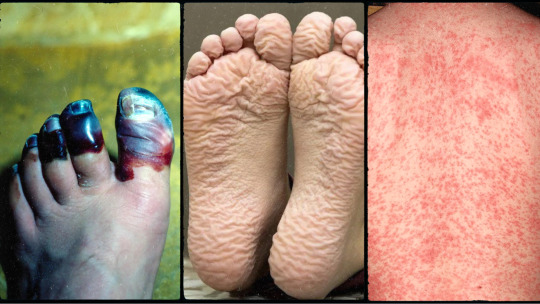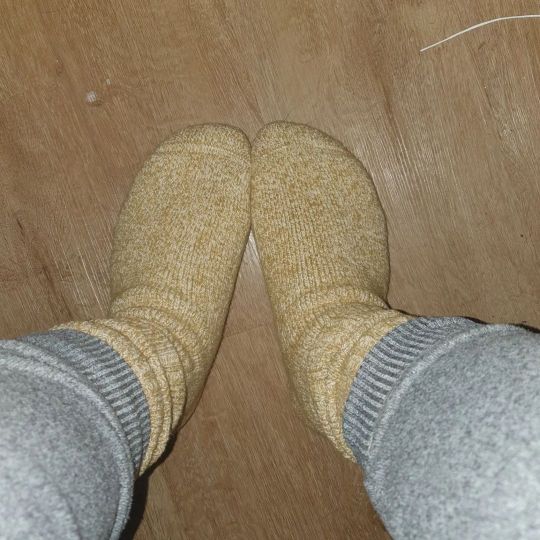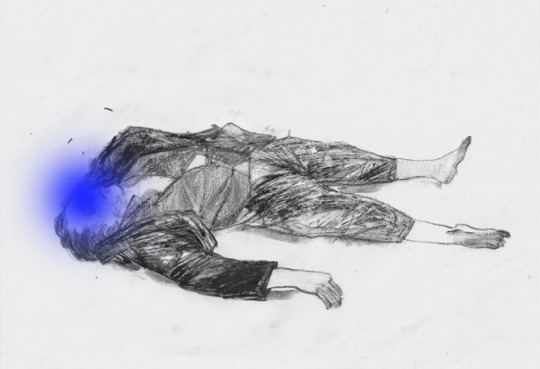#chilblains
Photo

Splash Pool - Oregon
Harry Snowden
#photographers on tumblr#oregon#pnw#waterfalls#wilderness#landscapes#adventure#hiking#chilblains#original photographers#nature
714 notes
·
View notes
Text

based on the sensation in my hands from pernio
3 notes
·
View notes
Text
i have chilblains on my elbow and it’s so irritating that i can’t sleep
#chilblains#disability#chronic illness#actually disabled#disabled#chronically ill#cripple punk#spoonie#cripplepunk#physically disabled#cpunk#chronic pain#chronic fatigue#crip punk#potsie#physical disability#pots#actually chronically ill#actuallydisabled#pots syndrome#autoimmine disease
4 notes
·
View notes
Text
Weather-Related Illnesses

** Pictured above (from left to right) are examples of frostbite, trench foot, and heat rash. **
Cold-related illnesses
Chilblains
Caused by repeated exposure of the skin to temperatures just above freezing to as high as 60 Fahrenheit. The cold exposure damages the capillary beds (groups of small blood vessels) in the skin. The damage is permanent and the redness/itching typically occurs on cheeks, ears, fingers, and toes, and will return with additional exposure.
Symptoms: redness, itching, possible blistering, inflammation, possible ulceration in severe cases.
First aid: Avoid scratching; slowly warm the skin; use corticosteroid creams to relieve itching and swelling; keep blisters & ulcers clean & covered.
Frostbite
An injury to the body caused by freezing. It causes loss of feeling and color in the affected areas. Most often affects the nose, ears, cheeks, chin, fingers or toes. It can permanently damage tissues, and severe cases can lead to amputation. In extremely cold temperatures, the risk of frostbite is increased in people with reduced blood circulation and who are not dressed properly.
Symptoms: reduced blood flow to hands & feet (fingers & toes can freeze), numbness, tingling or stinging, aching, bluish or pale waxy skin.
First aid: Get into a warm room as soon as possible; do not walk on frostbitten feet or toes unless absolutely necessary (as this worsens the damage); immerse the affected area in warm -- NOT HOT -- water (temp should be comfortable to the touch by unaffected areas); warm the affected area using body heat (such as warming frostbitten fingers in your armpits); don't rub or massage the frostbitten areas since this can worsen the damage; don't use heating pads, heat lamps or stoves, fireplaces or radiators for warming since numbness of affected areas can lead to burns.
Hypothermia
Abnormally low body temperature caused by prolonged exposure to cold temperatures. Body temperatures that are too low can affect the brain, affecting the victim's ability to think and/or move well. This can make hypothermia dangerous as the victim may not realize it's happening and will not be able to do anything about it before it's too late.
Symptoms: Early symptoms are shivering, fatigue, loss of coordination, and confusion/disorientation. Late symptoms are no shivering, blue skin, dilated pupils, slowed pulse & breathing, loss of consciousness.
First aid: Move the victim into a warm room or shelter; remove wet clothing; warm the center of the body first (chest, neck, head & groin) using an electric blanket (if available), or you can use skin-to-skin contact under loose, dry layers of blankets, clothing, towels, or sheets; warm beverages can help increase body temperature (but avoid alcoholic beverages, and do not try to give beverages to an unconscious person); after body temp has increased, keep the victim dry and wrapped in a warm blanket, including the head and neck; if the victim has no pulse, begin CPR compressions.
Trench Foot
Also known as "immersion foot," this injury of the feet results from prolonged exposure to wet and cold conditions. It can occur at temperatures as high as 60 Fahrenheit if the feet are constantly wet. Injury occurs because wet feet lose heat 25 times faster than dry feet -- to combat the heat loss, the body constricts blood vessels to shut down circulation in the feet. Skin tissue then begins to die because of lack of oxygen and nutrients and the buildup of toxins.
Symptoms: reddening of the skin, numbness, leg cramps, swelling, tingling pain, blisters/ulcers, bleeding under the skin, gangrene (foot may turn dark purple, blue or gray).
First aid: Remove shoes/boots and wet socks; dry the feet; avoid walking on feet, as this can cause further damage.
Heat-related illnesses
Heat cramps
Heat cramps can occur when one sweats too much during strenuous activity, which depletes the body's salt & moisture levels. Low salt levels in muscles can cause cramping, though cramps can also be a symptom of heat exhaustion.
Symptoms: muscle cramps, pain, or spasms in abdomen, arms and/or legs.
First aid: drink water and have a snack that replaces carbohydrates and electrolytes (such as sports drinks) every 15 to 20 minutes; avoid salt tablets; get medical help if the victim has heart problems, is on a low-sodium diet, and/or has cramps that don't subside within 1 hour.
Heat exhaustion
Heat exhaustion is the body's response to an excessive loss of water and salt, usually through sweating. It's most likely to affect the elderly, people with high blood pressure, and those working in hot environments.
Symptoms: headache, nausea, dizziness, weakness, irritability, thirst, heavy sweating, elevated body temperature, decreased urine output.
First aid: Remove victim from the hot area and give liquids to drink; remove unnecessary clothing (including shoes and socks); cool the victim with cold compresses or have them wash their head, face, and neck with cold water; encourage them to take frequent sips of cool water.
Heat rash
Heat rash is an ailment caused by excessive sweating in hot, humid weather.
Symptoms: red clusters or pimples or small blisters usually appearing on the neck, upper chest, groin, under the breasts, and in elbow creases.
First aid: keep the rash area dry; apply powder to increase comfort; don't use ointments and creams.
Heat stroke
This is the most serious of the heat-related illnesses and occurs when the body can no longer control its temperature -- the body temperature rises rapidly, the sweating mechanism fails, and the body is unable to cool down. When heat stroke occurs, body temps can reach 106 Fahrenheit or more in just 10 to 15 minutes. It can cause permanent disability or death if emergency treatment isn't received.
Symptoms: confusion or altered mental status and/or slurred speech, loss of consciousness (coma), hot/dry skin or profuse sweating, seizures, very high body temperature, fatal if treatment delayed.
First aid: move the victim to a shaded, cool area and remove outer clothing; circulate the air around the victim to facilitate cooling; place cold, wet cloths or ice on the head, neck, armpits, or groin, or soak the clothing with cool water; cool the victim quickly using any of the following methods:
with a cold water or ice bath (if possible);
wet the skin;
place cold, wet cloths on the skin;
soak clothing with cool water.
Heat syncope
Heat syncope is fainting and/or dizziness that usually occurs when standing for too long or suddenly standing up after sitting or lying. Factors that may contribute to heat syncope include dehydration and lack of acclimization.
Symptoms: fainting (short duration), dizziness, light-headedness from standing too long or suddenly rising from a sitting or lying position.
First aid: sit or lie down in a cool place; slowly drink water, clear juice, or a sports drink.
Rhabdomyolysis
This illness is associated with prolonged physical exertion and heat stress. It causes the rapid breakdown, rupture, and death of muscle. When muscle tissue dies, electrolytes and large proteins are released into the bloodstream, which can cause irregular heart rhythms, seizures, and damage to the kidneys.
Symptoms: muscle cramps/pain, abnormally dark (tea or cola-colored) urine, weakness, exercise intolerance, asymptomatic.
First aid: stop activity immediately; drink more liquids (preferably water); seek immediate care at the nearest medical facility, if possible, and ask to be tested for rhabdomyolysis (a blood sample analyzed for creatine kinase).
Source: www.cdc.gov
#h&fa#h&kc#outdrs#first aid#heat stroke#heat exhaustion#rhabdomyolysis#heat syncope#heat rash#heat cramps#chilblains#frostbite#hypothermia#trench foot#medical emergency
4 notes
·
View notes
Text
Fellow chronic illness possessors: this is the worst winter yet for my feet. The chilblains are absolutely wrecking me. Anyone have tips or tricks for lessening the pain?
0 notes
Photo

New socks to counteract my Reynaud's and Chilblains! Some Norwegian wool ones to hopefully keep them at an even temp and then some compression socks for general blood flow. #reynaudssyndrome #chilblains #chronicillness (at Ipswich, Suffolk) https://www.instagram.com/p/Cn2GKj7MHWt/?igshid=NGJjMDIxMWI=
1 note
·
View note
Video
Skin sores or bumps that occur after exposure to very cold temperatures.
#chilblains#covid#podiatry#coldfeet#winter#raynauds#podiatrist#arthritis#spoonie#coronavirus#feet#dermatology#Drugcarts#onlinepharmacy#pharmacy#naturalmedicine#healthcare#doctor#medicine#covidtoes#chronicpain#fibromyalgia#ehlersdanlossyndrome#footcare
1 note
·
View note
Text
The Adventures Of Pinocchio 1883 Review Ch 13-18
chapter 13
Cat says he feels weak and proceeds to eat unholy amounts of cheese. Fox sats he's on a diet, proceeds to eat all possible meat available in Italy.
Crickets ghost appears and says some typical
The Cat receives a telegram that his firstborn is dying from chilblains, dark much?
talking cricket stuff, "I want to give you some good advice blablabla..." something like that
Chapter 14
Pinocchio has a tongue, I think this was mentioned before but it's weird, right? He also eats things, I just don't quite understand his biology. Pinocchio thinks he can defeat assassins with words, such a pinocchio moment he is stupid. The assassins are very clearly the fox and cat from earlier and are just regular crooks not assassins, right? They wouldn't kill anyone
Chapter 15
I was wrong they would kill someone.
Creepy little blue haired girl won't let pinocchio in her home because she is dead and waiting for her coffin, dead people can't talk this is confusing. The assassins stab pinocchio obviously this doesn't do anything because he's wooden so then the assassins hang pinocchio, yes they hang him with a noose on a tree, and no pinocchio is not invulnerable to suffocating, he does survive but it says "death was creeping nearer and nearer" so despite his wooden neck he is definitely slowly dying .
Chapter 16
Pinocchio is saved by the blue hair girl, it's revealed she's some old fairy I think this is the Blue Fairy who I know of vaguely. Then my favourite character yet is revealed, Medoro the Poodle, I’ll make a seperate post about him. Then the doctors arrive and one of them is The Talking Cricket, I've now just realised why is he called the talking cricket but other talking animals don't have talking in their title, is he the last of his kind? I also love the other doctors observations, Dr owl basically says he's dead but if he's alive then that's proof he's alive" and Dr crow says he's alive but if he was dead that would be proof that he's dead
Chapter 17
This whole chapter is just telling kids to take medicine when they're sick and not be a stupid baby and die from illness because they didn't take their medicine. Just a life lesson for kids I guess. Oh also this the chapter when his nose starts growing. The fairy explains "there are two kinds of lies, lies with short legs and lies with long noses" this does not explain anything
Chapter 18
So pinocchio's nose grew rather long, how do you think it gets back to normal? The fairy summons a thousand woodpeckers of course.
This fox and cat are such a bad influence.
The city of simple Simon's is filled with hairless mammals, combless chickens, colourless butterflies (which means they can’t fly because obviously its the colour not the wings that make them fly) and etc.
#pinocchio#classic literature#fantasy#chilblains#cricket#long nose#hairless mammals#dark fantasy#murder#blue fairy#fairy#fairytale#fairytales
0 notes
Photo

swelling cold
#the sun is so close#swelling cold#chilblain#frostbite#dead body#death#suffering#darkness#air#void#alone#lucjan_
181 notes
·
View notes
Text
i usually read a Jane Austen book every December but I've read all* of them now so now i'm reading Longbourn by Jo Baker and aaaaaaaaaaa a.. a aaaaaaaaaaaaaaaa AAAAAAAAAAA AAAA AAAAAAAAA. AAA !!!!!!
#Sometimes I forget who I am#And then sometimes I read a novel about a maidservant in 18th-19thc England#And I am like HAVE YOU HEARD OF MARX WHAT ABOUT ELEANOR MARX#BUT SHE HASN'T!!!!!!! Because it's 1790!!!!!#IF SOMEONE DOESN'T GET THIS GIRL SOMETHING FOR HER CHILBLAINS I'M GOING TO LOSE MY MIND#LIBERATION!!!! SOME LIBERATION FOR HER CHILBLAINS!#Can I get u some revolutionary pamphlets I bet there were some French ones SOMEWHERE#All petty fights between factions of leftism fade away#consider that anyone with a philosophy that could help a woman living in this situation is a comrade of mine#Me Fein#longbourn#jo baker#pride and prejudice#Oh yeah#* most of all of them. Couldn't get thru Lady Susan or Mansfield Park
8 notes
·
View notes
Text



i have an illness that make me rate everything i watch on mubi 5 stars 🏜️
#most feminine piece of clothing i own rn is this thermal top kinda cyunt#chilblains king.#my face#antyways i. Need a haircut so bad.
6 notes
·
View notes
Text

Splash Pool - Oregon
Harry Snowden
#photographers on tumblr#oregon#pnw#original photography#harry snowden#waterfalls#high cascades#Chilblains#hiking
3 notes
·
View notes
Text
I always forget that when I walk I also have to walk back
2 notes
·
View notes
Text
I have multiple illnesses and conditions right now that would have afflicted and killed not just a Victorian era child but any individual from the early 1900s perhaps too
#while i was in hospital for my ulcer the other fay my mother casually told me how her aunt (my grandma's sister) died of a ruptured ulcer in#the 50's while she was the SAME age as me.#also i thought i had reynauds because both my mother and sister have it but it's fucking chilblains?! wtf
0 notes
Text
wow I love january. i love the month where my hands get swollen and itchy and i can't do anything without it hurting. wow january
0 notes